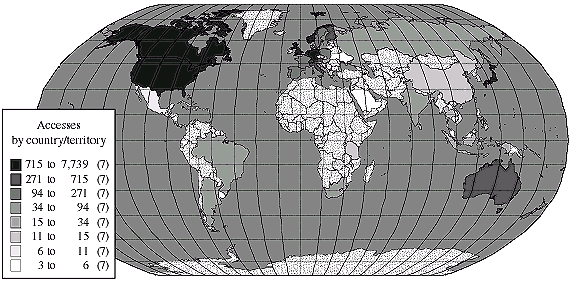Appendix VI: Open Process
The Terms of Reference of this Special Report on Emissions Scenarios (SRES)
include a so-called "open process" to stimulate input from a community of experts
much broader than the writing team (see Appendices I and
II). IPCC documents should take into account as many scientific
perspectives as possible. This is particularly important in the area of scenarios,
for which views on the plausibility of various aspects of the described futures
and their interactions can differ between regions, between different sectors
of society, and between individual experts. The SRES web site (sres.ciesin.org)
was created to facilitate the open process and to help gain input from a community
of experts much broader than the writing team.
The web site:
- Includes a description of SRES activities and the scenario development process.
- Provides detailed information on the four marker scenarios and their storylines.
- Offers facilities to view and plot scenario driving forces and emissions.
- Offers facilities to receive feedback from the open process.
The open process lasted from June 1998 to January 1999. As a result of the
interest in SRES scenarios, the web site is accessible to acquire updated information
about SRES marker scenarios. For other reasons and the input received so far,
the information on the web site has been improved and updated considerably.
The writing team recommends that the web site also be maintained in the future
so that it is available to access updated information on SRES scenarios. However,
this will require additional resources.
The four marker scenarios were posted on the IPCC web site (sres.ciesin.org)
in June 1998. The submissions invited through the open process and web site
fell into three categories:
- Additional scenarios published in the reviewed literature that had not been
included in the scenario database (see Appendix V).
- New scenarios based on the SRES marker scenarios.
- General suggestions to improve the work of the SRES writing team as posted
on the web site (preferably based on referenced literature).
| Table VI-1: SRES web site access
summary by month, from July 1998 to March 1999. |
|
|
Month
|
Unique non-CIESIN
hosts connected
|
Total non-CIESIN
www accesses
|
|
July 1998 (20-31)
August 1998
September 1998
October 1998
November 1998
December 1998
January 1999
February 1999
March 1999(1-5)
Total |
17
143
610
425
313
455
497
468
103
3,031 |
65
2,214
6,217
4,083
3,696
5,170
5,946
5,764
1,064
34,219 |
|
The submissions were used to revise the marker scenarios and to develop additional
alternatives within each of the four scenario families. The result is a more
complete, refined set of new scenarios that reflects the broad spectrum of modeling
approaches and regional perspectives. The preliminary scenarios posted on the
web site were provided to climate modelers also, with the approval of the IPCC
Bureau.
Most of the submissions received fall into the first two categories above.
Altogether, more than 34,000 accesses to the SRES web site were registered by
April 1999 from some 3,000 unique hosts that were connected. Tables VI-1
and VI-2 and Figure VI-1 give more
detail about the number of monthly accesses between July 1998 and March 1999
and about accesses from different countries and territories during the same
period. Tables VI-3 and VI-4
give details of the preliminary marker scenarios.
The web site is managed by the Center for International Earth Science Information
Network (CIESIN) in the US, in collaboration with the Energy Research Foundation
(ECN) in the Netherlands, the Technical Support Unit (TSU) of Working Group
III on Mitigation of IPCC at the National Institute of Public Health and Environment
(RIVM) in the Netherlands, and the International Institute for Applied Systems
Analysis (IIASA) in Austria.
|

Figure VI-1: SRES web site access summary
by countries and territories, from August 1998 to February 1999.
|
|